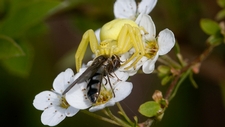Changes in Food Webs

TEKS Objective
The student is expected to describe the flow of energy through food webs, beginning with the Sun, and predict how changes in the ecosystem affect the food web such as a fire in a forest.
Essential Understanding
The student knows and understands that living organisms within an ecosystem interact with one another and with their environment.
Science Background
Food Chains, Changes to Food Webs: BBC Bitesize (website) - Answers to questions about the impact of changes that could (and do) occur within food chains and food webs. For example, what would happen if the population of slugs or insects decreased in a particular food chain? What would happen if the grass died?
Food Chains, Changes to Food Webs
BBC Bitesize, www.bbc.co.uk
Ecosystems: Eschool Today (website) - Information on systems, biomes, levels, cycles and more within an ecosystem.
Signature Lesson
Population Study Game: River Venture (PDF) - In this activity, students role play and simulate how plant and animal populations are affected, over time, by various changes in their ecosystem. Students record and graph their results for different scenarios. This activity is best conducted outdoors or in a large space, such as a hallway.
- Supporting Lessons
- Extensions
- Assessment Ideas
- Literature Connections
- Related
TEKS - Additional Resources
Supporting Lessons
Food Chain: Science NetLinks (website) - Explore the flow of matter and energy, and interdependence of life represented in food chains. Students learn to identify similarities and differences among a variety of food webs in different environments. Includes assessment and extensions.
Food Chain
Science NetLinks, www.sciencenetlinks.com
Food Webs: BioEd Online (website) - Students learn about producers, consumers and the interactions between them while constructing possible food webs for six different ecosystems.
Food Webs
BioEd Online, www.bioedonline.org
Food Web Unit: Fisheries Learning On the Web (PDF) - This series of five lessons focuses on aquatic food chains and freshwater ecosystems. Activities demonstrate that all living organisms in an ecosystem are connected and that this structure is sensitive to change, via introduction of non-indigenous species, for example, which can alter food webs and cause long-term ecological changes.
Food Web Units
Fisheries Learning on the Web, www.nsgl.gso.uri.edu
Elaboration Lessons and Extensions
Constructing Sonoran Desert Food Chains and Food Webs: Teach Engineering (website) - Complete activity, including student pages, in which students construct food chains and food webs using species endemic to the Sonoran Desert and investigate how food chains are interconnected, and how communities of organisms maintain themselves over years and generations.
Constructing Sonoran Desert Food Chains and Food Webs
Teach Engineering, www.teachengineering.org
Hare and Lynx Populations: My Science Box (website) - Students learn to graph population data and then interpret their graphs to identify factors that influence the predator-prey population cycle of the snowshoe hare and Canada Lynx.
Hare and Lynx Populations
My Science Box, www.mysciencebox.org
Survivor: University of Texas, Dallas (website) – Students simulate several different real ecosystems to investigate the impacts of introduced species on communities.
Assessment Ideas
Ask students to write one to two paragraphs on the main points of this lesson and what they learned that was the most interesting to them. Have them include (at minimum) the following vocabulary in their writing piece: sun, producer, consumer, decomposer, plants, animals, photosynthesis, food web, and food chain.
Literature Connections
Food Chains and Webs. Delta Education (ISBN-13: 978-1592422579)
Exploring Ecosystems with Max Axiom, Super Scientist. Biskup, Agnieszka (ISBN-13: 978-1429611565)
Who Eats What? Food Chains and Food Webs. Lauber, P. and Keller, H. (ISBN-13: 978-0064451307)
>The World of Food Chains with Max Axion, Super Scientist. O’Donnell, Liam (ISBN-13: 978-0736868396)
Food Webs: Interconnecting Food Chains. Gray, Susan (ISBN-13: 978-0756532611)
Pass the Energy, Please! Shaw McKinney, Barbara (ISBN-13: 978-1584690016)
What Are Food Chains and Food Webs? Vogel, Julia (ISBN-13: 978-1602707962)
The Food Web of a Tropical Rain Forest. Reagan D.P. and Waide R.B. (ISBN-13: 978-0226706009)
Additional Resources
Experiment with Ecosystems: Concord Consortium (Software and PDF) - Engaging series of activities in which students experiment with, and make predictions about a variety of virtual ecosystem models, and test their hypotheses about producer/consumer and predator/prey relationships. Download the free “Experiment with Ecosystems” software at http://www.concord.org/activities/experiment-ecosystems. Download the free PDF teacher guide, with instructions and student worksheets, at http://www.concord.org/sites/default/files/projects/er/materials/TeacherGuide_Activity10-TXMO-final.pdf.
TEKS Navigation
Grade 4
Need Assistance?
If you need help or have a question please use the links below to help resolve your problem.

Comments